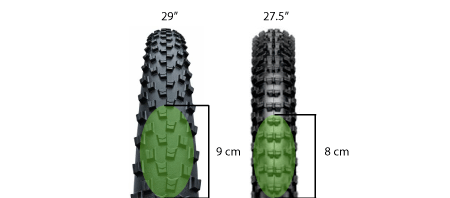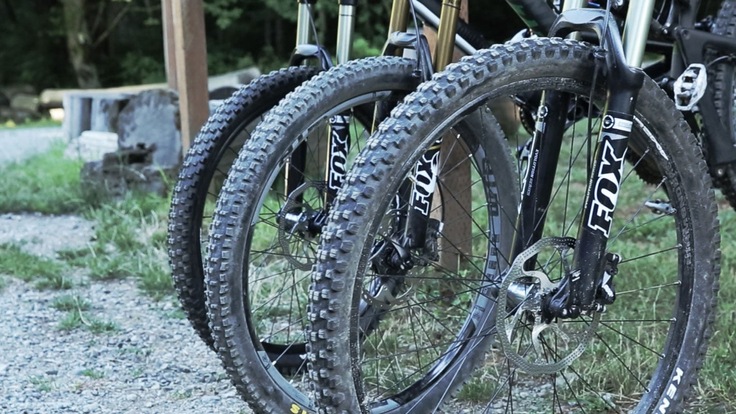For years, wheel size wasn't something most mountain bikers considered when shopping for a bike. That's because all mountain bikes came with standard 26 in. wheels.
Then, along came two wheel sizes that have, for the most part, overtaken 26 in. wheels. First on the scene were 29 in. wheels (29ers), followed a few years later by 27.5 in. (also known as 650b) wheels.
The right size for you largely depends on what you're looking to get from a mountain bike and the type of terrain you like to ride.
At-a-glance comparison of 27.5" vs. 29er mountain bikes:
| 27.5" | 29ers |
Acceleration | Faster | Slower |
Traction | Good | Better |
Attack angle | Good | Better |
Weight | Lighter | Heavier |
Maneuverability | Better | Good |
Fit | Favors shorter riders | Favors taller riders |
Take test rides: As you consider 27.5 and 29 in. wheels, keep in mind that the best way to learn the differences is to feel them for yourself. Swing by your local REI or bike shop and take each one for a test ride.
Acceleration
27.5 in. wheels have faster acceleration while 29ers are more efficient on longer rides.
Smaller wheels accelerate faster than larger wheels. This is due mostly to where the weight of the wheel is distributed. Larger wheels place the weight of the spokes, rims, tubes and tires farther from the center of the wheel, resulting in higher rotational mass and slower acceleration. When you cut down on the rotational mass of a rolling object it will roll faster and with more ease.
27.5": Faster acceleration is often cited as one of the biggest benefits of a 27.5" wheel when compared to a 29" wheel. Wheels that accelerate faster give a bike a snappy, responsive feel that many riders desire.
29": Wheels that accelerate slower take longer to get up to speed, possibly giving the bike an unresponsive feel. However, once the larger wheels reach top speed, they're actually more efficient for longer rides than smaller wheels because they require less effort to keep their momentum going.
Traction
Because of their greater surface area (aka "contact patch"), 29 in. wheels have better traction (when comparing comparable tires).

27.5 in.: These wheels provide very good traction and are good for most purposes. Other considerations, such as acceleration, weight and fit may ultimately be more important factors in your choice of wheel size.
29 in.: These wheels, with their larger contact patch, may be your best choice if grip on slippery rocks and roots is a top priority.
Attack Angle
29ers roll over objects more easily.
Attack angle is the angle formed when the round wheel touches a square object. A shallower angle is better because the wheel can roll more easily over the object.

27.5 in. wheels don't roll over objects as easily as 29ers, but they are still very capable. Think about where you'll be riding: if you'll mostly ride smooth trails, 27. 5 in. wheels will serve you just fine.
29 in. wheels have a slightly shallower attack angle than 27.5 in. wheels, making them better at rolling up and over any logs, roots and rocks that you'll encounter on the trail. Many riders feel more confident with larger wheels.
Weight
27.5 in. wheels are lighter.
There's no way around it; a larger wheel is heavier. Bikes with 29 in. wheels can weigh about 2 lbs. more than bikes with 27.5 in. wheels due to more wheel material and more tire rubber.
Depending on the type of riding you do, the weight of your bike may or may not be very important.
If you're a casual rider: The weight difference between 27.5 in. wheels and 29 in. wheels may not be your biggest concern. You might care more about traction and attack angle.
If you're competitive or go on long-distance cross-country rides: You'll probably be looking for ways to save weight. Going with a smaller wheel is one way to reduce weight, but it's not the only way. You can also look into ultralight carbon fiber frames, handlebars, seatposts and rims.
Setting your wheels up to be tubeless is another great way to reduce weight. Tubeless wheels not only reduce overall bike weight, but they also accelerate faster because of reduced rotational mass and they have the added benefit of being able to run at lower tire pressure for better traction.
Maneuverability (Frame Flex)
27.5 in. bikes are more maneuverable.
A 29 in. bike is more flexible due to the elongation of the frame that comes with the larger wheel size. This can result in a bike that feels harder to handle in tight turns.
If you regularly ride tight, twisty trails, you might prefer the feel of a 27.5 in. bike. 27.5 in. wheels retain a lot of the snappy feel of the original 26 in. size, while maintaining many of the benefits that come with a larger wheel.
29ers roll over obstacles more easily, so you may find you don't miss the snappy feel of smaller wheels, as you're able to go up and over rocks and roots rather than trying to quickly maneuver around them.
Fit
29ers are often better suited to taller riders.
The larger 29 in. wheels affect the overall geometry of a bike frame more drastically than 27.5 in. wheels. This can make it difficult for shorter riders (especially those shorter than 5 ft. 6 in.) to find a 29er that fits well. Test ride both wheel sizes if you can.
Taller riders, especially those over 6 ft. tall, may prefer the feel of a bike with 29 in. wheels. However, a bike with 27.5 in. wheels can also fit tall riders well, so decide where your priorities are related to acceleration, traction, attack angle and weight first.
